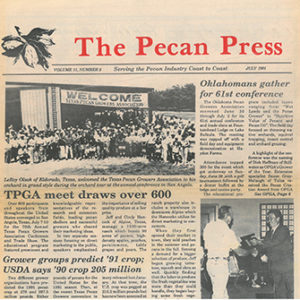Rooted in research
It takes an open mind to not only accept change, but to also embrace it. The late LeRoy Olsak saw many changes throughout his lifetime, and some would say his forward thinking led him to become known as one of the best pecan farmers in Texas.
“As a B-24 combat pilot of the Red Raider Bomber Group, Olsak flew many successful bombing missions over coastal China during World War II,” said John Begnaud ’74, a retired Texas A&M AgriLife Extension Service county horticulturist who worked closely with Olsak during his years as a pecan farmer. “During the last few years of his life, he actually sold pecans to people in China. LeRoy was very thankful to have lived long enough to see that kind of change in his lifetime.”
A PECAN PARTNERSHIP

Begnaud said Olsak was a proponent of evolution in the pecan industry, which made him an ideal partner for Texas A&M.
“LeRoy’s orchard was like a great pecan laboratory,” Begnaud added. “He opened his orchard to research, teaching and extension, giving Texas A&M the tools needed to further pecan research. There wasn’t a year that passed where he didn’t have something new to share.”
The partnership proved rewarding. While Texas A&M conducted groundbreaking research on Olsak’s orchard, he, in return, kept meticulous records on production and costs, which Begnaud explained is crucial to the prosperity, feasibility and economics of growing pecans.
However, aside from the research that Olsak thirsted for, Begnaud said his old friend simply had a gift for growing pecans. “He held the magic combination of success: plenty of sunlight, deep soil and great quality freshwater.”
Olsak’s knack for pecan farming earned him more than one championship title at the Texas Pecan Growers Association’s, TPGA, annual Texas Pecan Show.
“Many say, at his peak, LeRoy had the best pecan orchard in Texas,” Begnaud said. In 1991, Olsak had the opportunity to open his orchard to more than 400 visitors through the TPGA’s annual conference. “More than nine busloads of people came to see his efforts and learn from LeRoy,” Begnaud recalled. “It was a highlight of his career.”
FUNDS FOR FUTURE GROWTH
While not Aggies by degree, Begnaud said Olsak and his wife, Sally, embodied the Aggie spirit and were very appreciative of their rewarding partnership with Texas A&M. The couple chose to show that appreciation by giving a cash contribution to the Texas A&M Pecan Endowment during Olsak’s lifetime, and another planned gift through a bequest in their estate.
Today, the couple’s gifts help fund research, education and extension activities, which will have a lasting impact on the pecan industry.
“The external funding we receive is crucial to support the ongoing maintenance and operations of our pecan orchards,” explained Dan Lineberger, Ph.D., professor and head of Texas A&M’s Department of Horticultural Sciences. “Even though the orchards are a critical component of our extension outreach and teaching programs, we just don’t have enough internal funding to sustain them.”

Lineberger said the orchards enable his department to research modern production methods, study insects and disease pests prevalent to pecans, and evaluate new pecan varieties developed through the U.S. Department of Agriculture Pecan Research program located nearby.
“The orchards are also a critical part of the annual pecan short course held in January, in which growers and potential growers visit from different states, as well as several foreign countries. It’s an important national and international asset to the pecan industry,” he said.
George Ray McEachern, Ph.D., professor in horticultural sciences, agreed with the program’s importance beyond Aggieland.
“The pecan program at Texas A&M is vast and known by most Texas pecan growers,” McEachern explained. “The Texas Pecan Growers Association has requested Texas A&M leadership to continue extension and research efforts to support its members. The success of these types of partnerships is evident through stories like LeRoy and Sally Olsak. The extension service has, and will continue to be, just as much about the people as it is about the crops.”
One of the most important areas this type of gift supports is hands-on learning for Texas A&M students.
“Many students trained in the orchard are now in very responsible positions in the pecan industry,” Lineberger said. “Our students are involved in the research component, but they also assist with harvesting, processing and selling pecans as a fall fundraiser hosted by the Texas A&M Horticulture Club,” Lineberger explained. “This tradition has become part of the Texas A&M culture. Members of the Aggie family eagerly await the pecan sales every year!”
From invaluable research to learning experiences, LeRoy and Sally’s gifts are providing continued growth for Texas A&M and the pecan industry in a very big way.
“It was LeRoy and Sally’s desire for the next generation to be as successful as they were, and it was important that their actions supported that,” Begnaud said. “Their gifts ensure that, but I always say their ‘payback’ to Texas A&M occurred many years before these contributions.”
This story was originally published by the Texas A&M Foundation.


